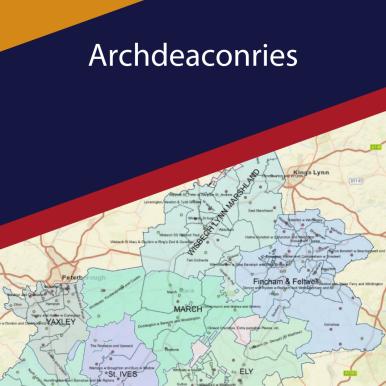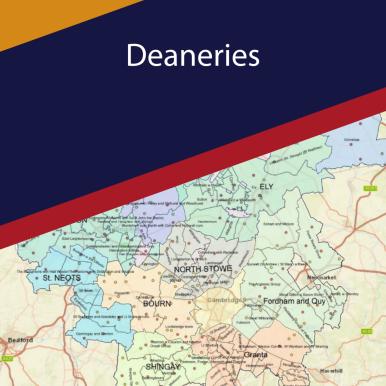The Diocesan structure at a glance
Background
In addition to the information below, visitors might find the Find a Church tool helpful. Click here to see more.
Frequently people may also need to find their church, parish, benefice or deanery codes in order to perform their duties, This link opens a spreadsheet to help you find this information. (Please note that depending on your internet browser this file might download to your browser screen at the bottom of this window).
A Diocese
The Church of England is divided into areas called dioceses. A diocese is the main administrative and pastoral area in the Church of England. Their boundaries often roughly coincide with those of local county boundaries.
An Archdeaconry
Each diocese is then divided into areas called archdeaconries. The number of archdeaconries each diocese has will depend on the area being served, the Diocese of Ely has two archdeaconries; the Archdeaconry of Cambridge (in the south) and the Archdeaconry of Huntingdon and Wisbech (in the north).
Each archdeaconry has an archdeacon, who is a senior member of the clergy, appointed by the Diocesan Bishop. Among many other duties, archdeacons are responsible for the administration and pastoral oversight of their archdeaconry.
A Deanery
Archdeaconries are divided into areas called deaneries. The Diocese of Ely has fifteen deaneries, with each appointed a Rural Dean. Rural Deans are senior members of the clergy who have administrative and pastoral oversight of their deanery, much like archdeacons have oversight of their archdeaconry.
A Benefice
A deanery is divided into areas called benefices. Each deanery may have one or many benefices. Very broadly speaking, most deaneries in the Diocese of Ely have somewhere between 1 and 6 benefices. Members of clergy (your vicar and priest) are normally Licensed by the Diocesan Bishop to serve at the benefice level.
Parishes
Benefices are divided into areas called parishes. A benefice may have one parish (known as a single-parish benefice), but it is not unusual for a benefice to have 2, 3 or more parishes within its boundaries (known as multi-parish benefices).
A parish is typically the area most people understand as the “church” – serving their local village or town community. Church of England parish boundaries don’t necessarily align with local council parish boundaries, but they are usually similar. Typically, a Church of England parish will have one church building in it, but this is also not always the case.
Changing boundaries
It is worth noting that the various Church of England areas (dioceses, archdeaconries, deaneries, benefices and parishes) are not set in stone. Rarely do boundaries change at the diocese or archdeaconry level, but as dioceses adjust to meet the needs of their communities, it is not unusual for benefices and parishes in particular to undergo pastoral reorganisation, which may bring individual areas together as one, or split them up.
During most years, the Diocese of Ely will undertake at least 2 or 3 changes to area boundaries that change the composition of a deanery or benefice.
Dioceses Commission
A new Dioceses Commission was set up in 2008. It has a primary duty to keep under review the provincial and diocesan structure of the Church of England, in particular:
- the size, boundaries and number of provinces;
- the size, boundaries and number of dioceses and their distribution between the provinces;
- the number and distribution of bishops and the arrangements for episcopal oversight.
Explore the Deanery Maps
The maps embedded below include a range of data from church, school, census, deprivation and parish boundary information, as well as Statistics for Mission and Return of Parish Finance data.
Information from these maps is provided by the Research and Statistics Team at the Church of England and is subject to change and alteration, so should be used as a guide only.
If your web browser fails to open the map below, you can open it instead using the link here.


